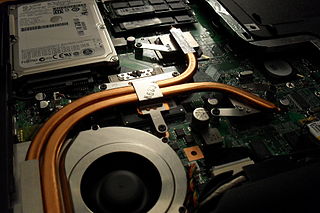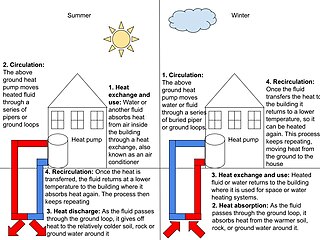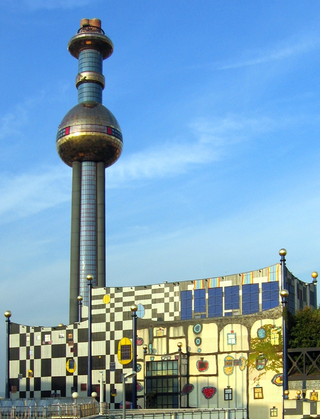
Geothermal energy is thermal energy extracted from the Earth's crust. It combines energy from the formation of the planet and from radioactive decay. Geothermal energy has been exploited as a source of heat and/or electric power for millennia.

A heat exchanger is a system used to transfer heat between a source and a working fluid. Heat exchangers are used in both cooling and heating processes. The fluids may be separated by a solid wall to prevent mixing or they may be in direct contact. They are widely used in space heating, refrigeration, air conditioning, power stations, chemical plants, petrochemical plants, petroleum refineries, natural-gas processing, and sewage treatment. The classic example of a heat exchanger is found in an internal combustion engine in which a circulating fluid known as engine coolant flows through radiator coils and air flows past the coils, which cools the coolant and heats the incoming air. Another example is the heat sink, which is a passive heat exchanger that transfers the heat generated by an electronic or a mechanical device to a fluid medium, often air or a liquid coolant.

A borehole is a narrow shaft bored in the ground, either vertically or horizontally. A borehole may be constructed for many different purposes, including the extraction of water, other liquids, or gases. It may also be part of a geotechnical investigation, environmental site assessment, mineral exploration, temperature measurement, as a pilot hole for installing piers or underground utilities, for geothermal installations, or for underground storage of unwanted substances, e.g. in carbon capture and storage.

A heat pipe is a heat-transfer device that employs phase transition to transfer heat between two solid interfaces.
Well logging, also known as borehole logging is the practice of making a detailed record of the geologic formations penetrated by a borehole. The log may be based either on visual inspection of samples brought to the surface or on physical measurements made by instruments lowered into the hole. Some types of geophysical well logs can be done during any phase of a well's history: drilling, completing, producing, or abandoning. Well logging is performed in boreholes drilled for the oil and gas, groundwater, mineral and geothermal exploration, as well as part of environmental and geotechnical studies.

Geothermal heating is the direct use of geothermal energy for some heating applications. Humans have taken advantage of geothermal heat this way since the Paleolithic era. Approximately seventy countries made direct use of a total of 270 PJ of geothermal heating in 2004. As of 2007, 28 GW of geothermal heating capacity is installed around the world, satisfying 0.07% of global primary energy consumption. Thermal efficiency is high since no energy conversion is needed, but capacity factors tend to be low since the heat is mostly needed in the winter.

District heating is a system for distributing heat generated in a centralized location through a system of insulated pipes for residential and commercial heating requirements such as space heating and water heating. The heat is often obtained from a cogeneration plant burning fossil fuels or biomass, but heat-only boiler stations, geothermal heating, heat pumps and central solar heating are also used, as well as heat waste from factories and nuclear power electricity generation. District heating plants can provide higher efficiencies and better pollution control than localized boilers. According to some research, district heating with combined heat and power (CHPDH) is the cheapest method of cutting carbon emissions, and has one of the lowest carbon footprints of all fossil generation plants.

A thermal power station, also known as a thermal power plant, is a type of power station in which the heat energy generated from various fuel sources is converted to electrical energy. The heat from the source is converted into mechanical energy using a thermodynamic power cycle. The most common cycle involves a working fluid heated and boiled under high pressure in a pressure vessel to produce high-pressure steam. This high pressure-steam is then directed to a turbine, where it rotates the turbine's blades. The rotating turbine is mechanically connected to an electric generator which converts rotary motion into electricity. Fuels such as natural gas or oil can also be burnt directly in gas turbines, skipping the steam generation step. These plants can be of the open cycle or the more efficient combined cycle type.

Casing is a large diameter pipe that is assembled and inserted into a recently drilled section of a borehole. Similar to the bones of a spine protecting the spinal cord, casing is set inside the drilled borehole to protect and support the wellstream. The lower portion is typically held in place with cement. Deeper strings usually are not cemented all the way to the surface, so the weight of the pipe must be partially supported by a casing hanger in the wellhead.

A ground-coupled heat exchanger is an underground heat exchanger that can capture heat from and/or dissipate heat to the ground. They use the Earth's near constant subterranean temperature to warm or cool air or other fluids for residential, agricultural or industrial uses. If building air is blown through the heat exchanger for heat recovery ventilation, they are called earth tubes.
Seasonal thermal energy storage (STES), also known as inter-seasonal thermal energy storage, is the storage of heat or cold for periods of up to several months. The thermal energy can be collected whenever it is available and be used whenever needed, such as in the opposing season. For example, heat from solar collectors or waste heat from air conditioning equipment can be gathered in hot months for space heating use when needed, including during winter months. Waste heat from industrial process can similarly be stored and be used much later or the natural cold of winter air can be stored for summertime air conditioning.

A ground source heat pump is a heating/cooling system for buildings that use a type of heat pump to transfer heat to or from the ground, taking advantage of the relative constancy of temperatures of the earth through the seasons. Ground-source heat pumps (GSHPs)—or geothermal heat pumps (GHP), as they are commonly termed in North America—are among the most energy-efficient technologies for providing HVAC and water heating, using far less energy than can be achieved by burning a fuel in a boiler/furnace or by use of resistive electric heaters.

The potential for exploiting geothermal energy in the United Kingdom on a commercial basis was initially examined by the Department of Energy in the wake of the 1973 oil crisis. Several regions of the country were identified, but interest in developing them was lost as petroleum prices fell. Although the UK is not actively volcanic, a large heat resource is potentially available via shallow geothermal ground source heat pumps, shallow aquifers and deep saline aquifers in the mesozoic basins of the UK. Geothermal energy is plentiful beneath the UK, although it is not readily accessible currently except in specific locations.

A direct exchange (DX) geothermal heat pump is a type of ground source heat pump in which refrigerant circulates through copper tubing placed in the ground unlike other ground source heat pumps where refrigerant is restricted to the heat pump itself with a secondary loop in the ground filled with a mixture of water and anti-freeze.
The study of Massachusetts Institute of Technology "The Future of Geothermal Energy – Impact of Enhanced Geothermal Systems (EGS) on the United States in the 21st Century" (2006) points out the essential importance of developing an economical deep geothermal boring technology. With old boring technologies, bore price rises exponentially with depth. Thus, finding a boring technology with which the bore price rise would be approximately linear with increasing bore depth is an important challenge.
The Glossary of Geothermal Heating and Cooling provides definitions of many terms used within the Geothermal heat pump industry. The terms in this glossary may be used by industry professionals, for education materials, and by the general public.
Aquifer thermal energy storage (ATES) is the storage and recovery of thermal energy in subsurface aquifers. ATES can heat and cool buildings. Storage and recovery is achieved by extraction and injection of groundwater using wells. Systems commonly operate in seasonal modes. Groundwater that is extracted in summer performs cooling by transferring heat from the building to the water by means of a heat exchanger. The heated groundwater is reinjected into the aquifer, which stores the heated water. In wintertime, the flow is reversed — heated groundwater is extracted.
Renewable thermal energy is the technology of gathering thermal energy from a renewable energy source for immediate use or for storage in a thermal battery for later use.
Multilevel Groundwater Monitoring Systems, also referred to as Multi-Depth Groundwater Monitoring Systems, Multilevel Systems (MLSs), or Engineered Nested Wells, are engineered technologies installed in single boreholes above and/or below the water table to obtain data from different depth intervals. The technologies may consist of various pipes, liners, access ports, sampling pumps, pressure sensors, and sealing mechanisms that are installed temporarily or permanently in boreholes drilled into unconsolidated sediments or bedrock.

Cold district heating is a technical variant of a district heating network that operates at low transmission temperatures well below those of conventional district heating systems and can provide both space heating and cooling. Transmission temperatures in the range of approx. 10 to 25 °C (50–77 °F) are common, allowing different consumers to heat and cool simultaneously and independently of each other. Hot water is produced and the building heated by water heat pumps, which obtain their thermal energy from the heating network, while cooling can be provided either directly via the cold heat network or, if necessary, indirectly via chillers. Cold local heating is sometimes also referred to as an anergy network. The collective term for such systems in scientific terminology is 5th generation district heating and cooling. Due to the possibility of being operated entirely by renewable energies and at the same time contributing to balancing the fluctuating production of wind turbines and photovoltaic systems, cold local heating networks are considered a promising option for a sustainable, potentially greenhouse gas and emission-free heat supply.















